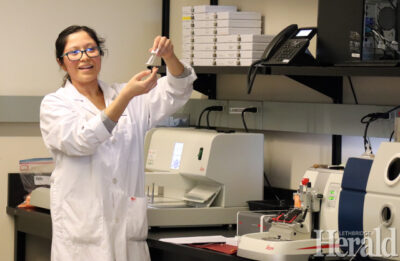Wildlife conservation lab named for professional outfitters society
By Alejandra Pulido-Guzman - Lethbridge Herald on January 17, 2025.
 Herald photo by Alejandra Pulido-Guzman
Above: Marcela Leija Montoya, lab technician demonstrate part of the process they use to analyze cementum from wildlife teeth to estimate age at the Thursday at Lethbridge Polytechnic.
Herald photo by Alejandra Pulido-Guzman
Above: Marcela Leija Montoya, lab technician demonstrate part of the process they use to analyze cementum from wildlife teeth to estimate age at the Thursday at Lethbridge Polytechnic.LETHBRIDGE HERALDapulido@lethbridgeherald.com
The Lethbridge Polytechnic announced Thursday they have named their Wildlife Conservation lab after their biggest financial contributor, the Alberta Professional Outfitters Society (APOS).
Over the last two years, APOS has donated nearly $350,000 to Lethbridge Polytechnic to enhance Canadian wildlife conservation which has contributed to the development and expansion of LP’s wildlife analytics lab, where employees and student researchers analyze cementum from wildlife teeth, primarily to estimate age.
Everett Hanna, instructor in the Environmental Sciences department explains Cementum is the substance that grows under the gum-line on teeth of all mammals, and it’s laid down in annual patterns that forms annuli or rings much like you would see in a tree.
“Using pretty specific equipment, we can decalcify teeth, make them soft, cut them very thin, stain them and look at them under a microscope to count those rings and estimate the age of animals at the very basic form,” says Hanna.
He says that thanks to their lab they are able to serve government agencies, but also academic researchers and private organizations, as well as just private hunters, trappers, naturalists who might want to know how old something is that they come across.
When talking about the importance of receiving funding, Hanna says they wouldn’t be where they are without the generous donations from APOS.
“That’s why we’ve taken this step, of course, to acknowledge APOS incredible contributions. We are pursuing other funding partners as well. However, APOS will remain a critical funding partner,” says Hanna.
He explains that the funding is everything for them to be able to operate, particularly with a revenue neutral business model, where they must generate sufficient funds to stay at that or around that equal line.
Corey Jarvis, president of APOS says APOS is very proud of the work the Wildlife Analytics Lab has already done to date to support wildlife conservation within Alberta and beyond and that is in big part a reason why they contributed financially.
“We were pleased to support the recent efforts for increasing the efficiency of the Lab using our Wildlife Management Fund and are honoured to have a place on campus bearing our name,” says Jarvis.
He says they are honoured to have played a role in developing this much needed service for wildlife management here in Alberta.
“This lab now plays a key role in filling a void in data collection that we recognize over the years. It’s hard to manage for quality and age structure without knowing the age of wildlife,” says Jarvis.
He adds that in the past, all the tooth aging and sampling was sent to the United States, so they thought this would be a good opportunity to bring it home.
“Across Canada now, there is an interest in shipping teeth to this lab. So, this is a first of its kind state of the art facility. This made in Alberta solution has really been a value to us,” says Jarvis.
16-15


